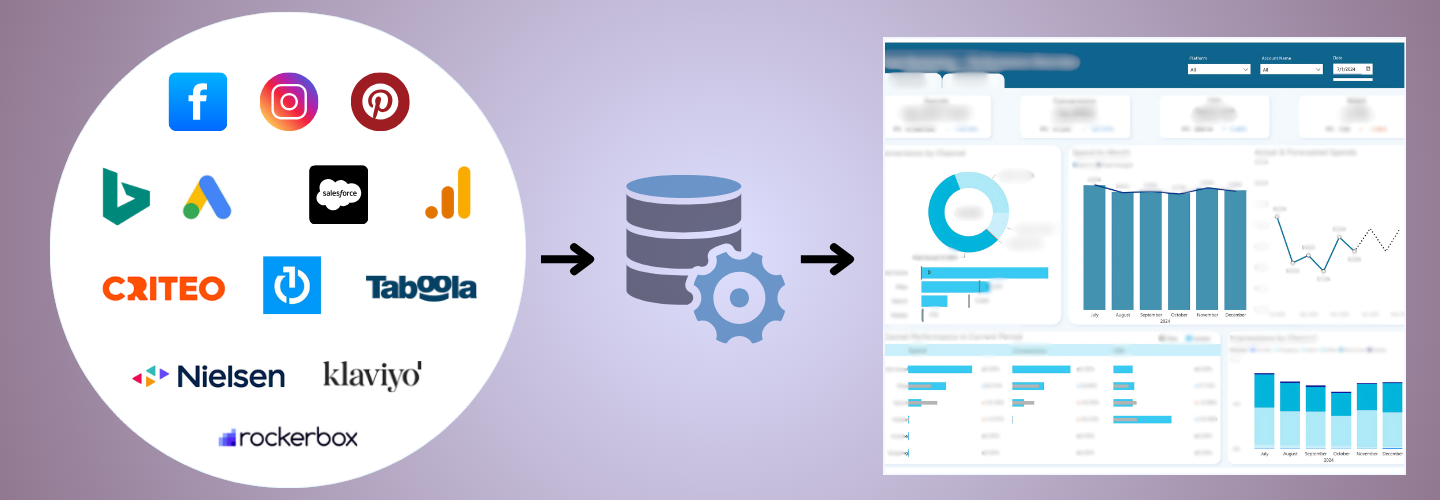Table of Contents
- What is Omnichannel Marketing Analytics?
- Key Components of Omnichannel Marketing Analytics
- Steps to Execute Omnichannel Marketing Analytics
- What Makes Omnichannel Different from Multichannel?
- Benefits of Omnichannel Marketing Analytics
- How to Get Started with Omnichannel Marketing Analytics
- Best Tools for Omnichannel Marketing Analytics
- Omnichannel Marketing in Different Industries
- Advanced Omnichannel Marketing Analytics Strategies
- Future Trends in Omnichannel Marketing Analytics
- Smarter Marketing Decisions Begin with Yavda’s Analytics Solutions
Marketing is no longer about running TV ads or billboards. Nowadays, people shop and interact with brands across different platforms. Firms must understand how buyers move between these platforms to provide a seamless experience. This is where omnichannel marketing analytics comes in.
Omnichannel marketing analytics helps businesses track and analyze customer behavior across many channels. It provides valuable insights about what customers desire, how they engage with a brand, and what influences their purchasing decisions.
This information allows firms to create personalized marketing campaigns, improve customer satisfaction, and increase sales. Without analytics, businesses would struggle to know which marketing strategies are working and which need improvisation.
This blog explains omnichannel marketing analytics in simple terms, covering its definition, importance, functionality, and tools. Whether you are a small enterprise owner or a marketing specialist, this blog will help you understand how to use data to improve your marketing strategies.
What is Omnichannel Marketing Analytics?
Omnichannel marketing analytics collects and examines data from multiple channels to understand customer behavior and optimize marketing efforts.
It helps businesses:
- Track customer interactions across different platforms
- Measure marketing performance
- Personalize customer experiences
- Improve ROI (Return on Investment)
Why Is It Important?
Consumers expect brands to know their choices and deliver relevant recommendations. Analytics helps firms understand customers' wants and deliver the right message to the audience at the right time.
Key Components of Omnichannel Marketing Analytics
1. Customer Data Tracking
Businesses collect data from various sources, such as websites, apps, emails, social media, and physical stores. For omnichannel marketing analytics, the most used tools are Google Analytics, CRM software, and social media insights. These tools help firms track real-time data.
2. Customer Journey Mapping
Mapping a customer’s journey helps understand how they move across different touchpoints before purchasing.
Example:
A consumer might:
- See an Instagram ad
- Visit the website to learn more
- Read online reviews
- Receive an email with a discount
- Make a purchase in-store
Studying this pattern helps firms better understand how they can maximize their marketing.
3. Cross-Channel Attribution
Attribution models help businesses determine which marketing channels contribute the most to conversions.
- First-click attribution: Gives credit to the first interaction
- Last-click attribution: Credits the last touchpoint before purchase
- Multi-touch attribution: Assigns credit to multiple interactions along the journey
4. Personalization & Customer Segmentation
Businesses can group customers based on behavior, preferences, and demographics to send personalized offers and recommendations.
Example:
- A customer who frequently buys electronics may receive a discount on gadgets.
- A new visitor may get a welcome email with a first-time purchase offer.
5. Real-Time Analytics & AI
Advanced tools use Artificial Intelligence (AI) to analyze real-time data and predict customer behavior. This helps in automating personalized marketing campaigns.
Steps to Execute Omnichannel Marketing Analytics
Step 1: Define Your Goals
Decide what you want to achieve. Common goals include:
- Increasing website traffic
- Boosting sales
- Improving customer retention
- Enhancing brand awareness
Step 2: Identify Key Marketing Channels
Determine which channels your audience uses the most. These may include:
- Social media (Facebook, Instagram, LinkedIn)
- Email marketing
- Paid ads (Google Ads, Facebook Ads)
- Website & SEO
- Physical stores
Step 3: Integrate Data Sources
Use tools like Google Analytics, CRM software, and marketing automation platforms to collect and unify data from different channels.
Step 4: Analyze Customer Behavior
Look at metrics like:
- Bounce rate: How many visitors leave your site without taking action?
- Click-through rate (CTR): How many people click on your ads or emails?
- Conversion rate: How many visitors turn into customers?
Step 5: Optimize and Personalize Campaigns
Use data insights to:
- Send personalized emails
- Improve ad targeting
- Offer discounts to high-value customers
Step 6: Monitor Performance and Adjust Strategies
Regularly review analytics reports and make adjustments to improve marketing performance.
What Makes Omnichannel Different from Multichannel?
Many businesses confuse multichannel and omnichannel marketing. Here’s the difference:

Benefits of Omnichannel Marketing Analytics
- Better Customer Experience: Understanding consumer behavior helps businesses create a seamless experience across all channels.
- Higher Conversion Rates: By personalizing messages and offers, businesses can increase conversions and sales.
- Improved ROI: Businesses can spend their budget wisely by focusing on the most effective marketing channels.
- Stronger Customer Relationships: Customers feel valued when they receive relevant content and personalized recommendations.
- Data-Driven Decision Making: Analytics helps businesses make informed decisions instead of relying on guesswork.
How to Get Started with Omnichannel Marketing Analytics
Follow these simple steps to implement an omnichannel strategy:
Step 1: Identify Key Customer Touchpoints
Where do customers interact with your brand? (Social media, email, mobile app, store visits)
Step 2: Integrate Data from All Channels
CRM software can be used to store customer data in one place.
Step 3: Use AI & Machine Learning for Predictive Analytics
AI helps predict customer behavior and recommend personalized marketing messages.
Step 4: Measure Performance and Optimize Strategies
Regularly analyze customer data to see what’s working and adjust marketing efforts accordingly.
Best Tools for Omnichannel Marketing Analytics
To track and analyze omnichannel data, businesses use the following tools:

Omnichannel Marketing in Different Industries
1. Retail Industry
Example: Walmart
- Walmart integrates its website, mobile app, and physical stores to provide real-time product availability.
- Customers can order online and pick up in-store (BOPIS - Buy Online, Pick-up in Store).
- AI-powered recommendations suggest items based on previous purchases.
2. Healthcare Industry
Example: CVS Health
- Patients can book doctor appointments online, get prescription reminders via SMS, and speak to chatbots for health advice.
3. Financial Services
Example: Bank of America
- Customers can manage accounts via mobile apps, in-branch visits, ATMs, and AI-powered chatbots.
- The bank predicts spending habits and provides personalized financial advice.
4. Hospitality & Travel
Example: Marriott Hotels
- Customers can book a hotel online, use the mobile app as a digital key, and receive personalized recommendations for nearby attractions.
Advanced Omnichannel Marketing Analytics Strategies
1. Predictive Analytics for Customer Behavior
Predictive analytics uses AI and machine learning to forecast customer behavior based on past interactions. Businesses can use this to:
- Identify customers likely to make a purchase
- Predict which products a customer might be interested in
- Determine the best time to send promotional emails or ads
Example:
An online clothing brand can analyze past purchase history and predict that a customer who bought winter jackets in November last year will likely shop for them again this year.
2. Customer Lifetime Value (CLV) Analysis
CLV helps businesses understand the total revenue a customer can generate over time. By using omnichannel analytics, brands can:
- Identify high-value customers
- Offer loyalty rewards and personalized promotions
- Focus marketing efforts on long-term customer relationships
3. AI-Powered Chatbots and Virtual Assistants
Brands use AI-driven chatbots to enhance omnichannel marketing by:
- Offering real-time support across websites, apps, and social media
- Personalizing product recommendations based on past interactions
- Providing 24/7 customer assistance without human intervention
Example:
A customer visits a website to browse sneakers but doesn’t purchase them. Later, a chatbot on Facebook Messenger sends them a discount code to encourage conversion.
Future Trends in Omnichannel Marketing Analytics
- AI-Powered Hyper-Personalization: AI will automate marketing campaigns that adapt in real-time based on customer behavior.
- Voice Search & Smart Assistants: More customers will shop via Alexa, Google Assistant, and Siri, requiring brands to optimize for voice search.
- Social Commerce Growth: Platforms like Instagram, TikTok, and Facebook will expand in-app shopping features.
- Augmented Reality (AR) & Virtual Reality (VR) Shopping: More brands will allow customers to "try before they buy" using AR-powered experiences.
- Blockchain & Data Privacy: With stricter data privacy laws, brands will use blockchain-based analytics to ensure secure customer tracking.
Smarter Marketing Decisions Begin with Yavda’s Analytics Solutions
Omnichannel marketing analytics helps firms create a seamless and personalized customer experience. By tracking customer interactions across multiple channels, businesses can optimize marketing strategies, improve engagement, and boost sales.
At Yavda, we specialize in omnichannel marketing analytics to help you get better returns from your marketing investments. By automating data collection and reporting, we free up your time, allowing you to focus on optimizing campaigns and increasing leads and sales.
Our intuitive reports and dedicated customer portals provide actionable insights at your command, allowing you to make better decisions across all marketing channels. With over 15 years of experience in Business Intelligence and Analytics and having built over 450 dashboards for more than 150 customers, we have the expertise to transform your marketing strategy.
To learn more about how Yavda can enhance your marketing strategy through omnichannel marketing analytics, please contact us. Our team is ready to provide personalized solutions to help you achieve better returns on your marketing investments.



